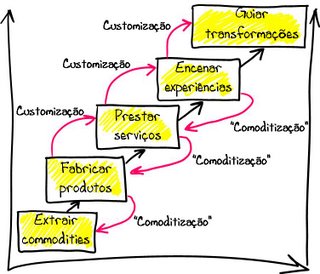Parte I e
parte II.
Como são as coisas... não há coincidências, todos os acasos são significativos.
Ontem à tarde, estive numa reunião de exploração estratégica numa empresa num sector tradicional da economia.
Empresa desenvolveu um produto a pedido dum cliente-fabricante. Entretanto, esse cliente chegou junto da marca e resolveu declinar o convite para produzir.
Marca, com produto na gama média-alta, resolveu avançar com a produção em Itália. Empresa resolveu fazer algo que nunca tinha feito antes, entrou em contacto com a marca, apresentou-se e ofereceu-se para continuar a fornecer a produção.
A internet ajudou-os a resolver o problema da distância (engraçado que antes da reunião ouvi este texto, "
The Problem For Small-Town Banks: Technology Has Redefined Community" e, durante a reunião recordei "
O fim da barreira geográfica")
Ou seja, a empresa está a considerar entrar no mundo da venda de projectos, em vez da venda de produtos, ou de soluções.
Também ando a pensar na relação da venda de projectos com o último nível desta
cadeia:





















